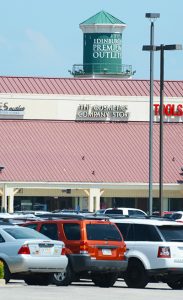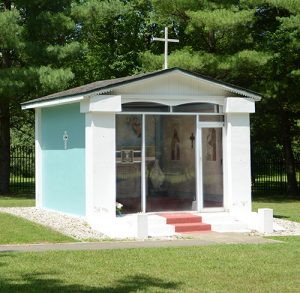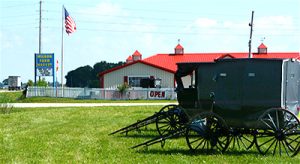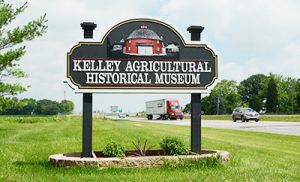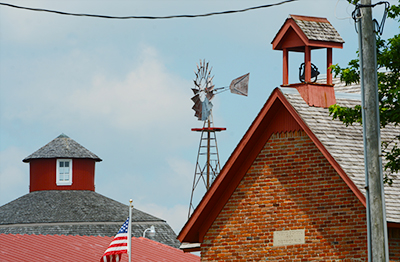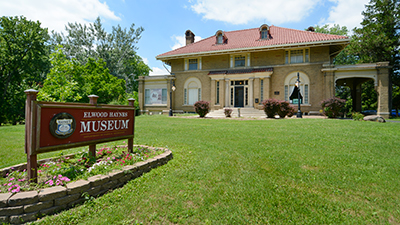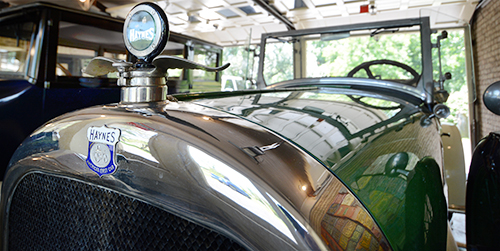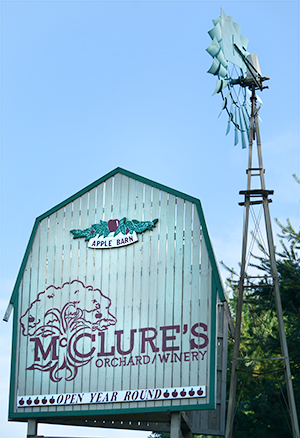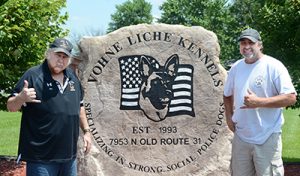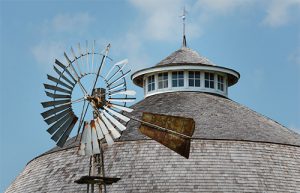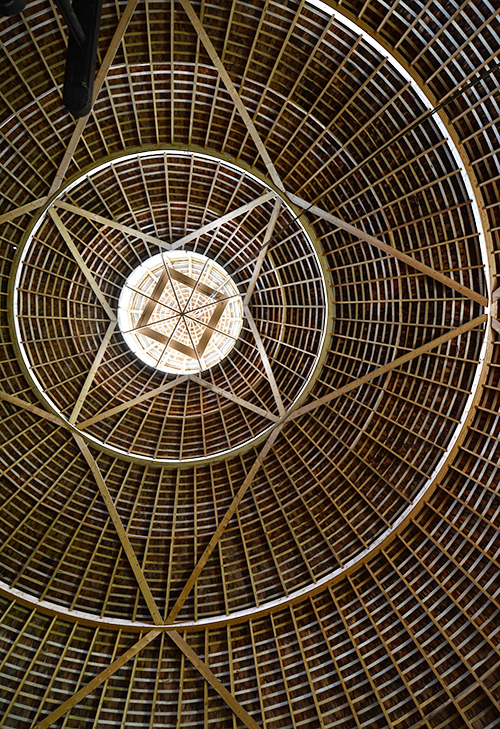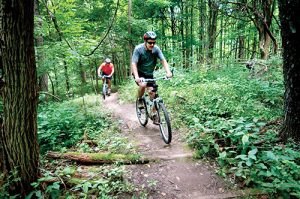It’s designated “U.S.” Route 31. But perhaps more than any other single state or federal highway, Route 31 truly traces the heart of Indiana. It’s really “Us 31.”
Literally, U.S. 31 wraps itself around Monument Circle in the very center of our state capital, and splits Indiana down the middle. North of Indianapolis, it’s a major thoroughfare, a direct four-lane spoke in between interstates 65 and 69. To the south of Indianapolis, U.S. 31 becomes a more leisurely two-lane retro road that parallels Interstate 65.
Figuratively, the some 270 miles 31 spends in Indiana takes motorists on a magical history tour from when cars and roads began replacing rivers, corduroy roads and steel rails.
So, take a ride with us this month as we highlight 31 unique and interesting places on or along 31 that encompasses so much Hoosier history, culture, lore and progress.
1
Falls of the Ohio River State Park, Clarksville.
Our first stop is on the banks of the Ohio River, just west of where U.S. 31 enters Indiana from the Clark Memorial Bridge.
At the Falls, in the fall of 1803, Meriwether Lewis rendezvoused with William Clark and together, with the core of their “Corps of Discovery,” set off on their famed expedition to the Pacific Ocean and back. A statue depicting the two adventurers meeting up is on the bluff next to the park’s Interpretive Center.
Below the center on the river’s edge, 386-million-year-old fossil beds are among the largest exposed (when the river cooperates) Devonian fossil beds in the world. The best time to visit the beds is when the river is lowest between August and October.
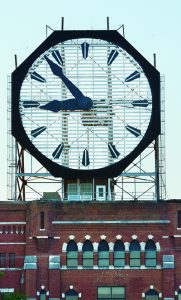 2
2
Colgate Clock, Clarksville.
Mere blocks from the Falls of the Ohio, the Colgate Clock has kept track of time for almost 100 years.
At 38-feet in diameter, the clock is reportedly the second largest time piece in the world. Its shape was inspired by Colgate’s octagonal soap when it was originally erected at the Colgate plant in New Jersey in 1906 to mark the company’s centennial. In 1924, a larger clock was erected at the New Jersey plant, and the original was brought to Indiana’s.
3
Clark County REMC, Sellersburg.
Headquartered not far off the 31 trail, Clark County REMC, incorporated in 1939, provides service to over 20,810 members living in Clark, Floyd, Jefferson, Scott and Washington counties.
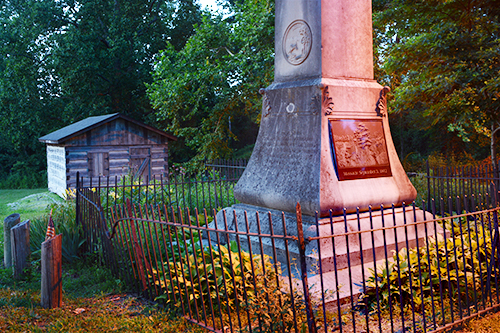 4
4
Pigeon Roost Massacre Memorial, Underwood.
The site off U.S. 31 memorializes the Sept. 3, 1812 surprise attack on the small Pigeon Roost settlement by a band of Native Americans. Fifteen children and nine adults were killed, marking the first deaths of Indiana settlers in the War of 1812. An obelisk and a memorial bench remember the victims. In addition, there is a rebuilt period cabin, picnic area, and cemetery at the site.
5
Muscatatuck National Wildlife Refuge, Seymour.
Muscatatuck National Wildlife Refuge is a 7,724-acre area of forest, wetland and grassland habitat just to the east of U.S. 31 as it passes by Seymour. The site provides resting and feeding areas for waterfowl during their annual migrations, and more than 280 species of birds have been seen at Muscatatuck.
6
Bartholomew County REMC, Columbus.
Founded in 1937, the REMC provides electricity to some 10,100 members in Bartholomew and parts of Decatur, Jackson and Jennings counties.
7
Columbus, Indiana: Architectural Mecca.
For a city its size, Columbus claims an astounding collection of architecturally significant buildings and art created by some of the biggest names in modern art and architecture.
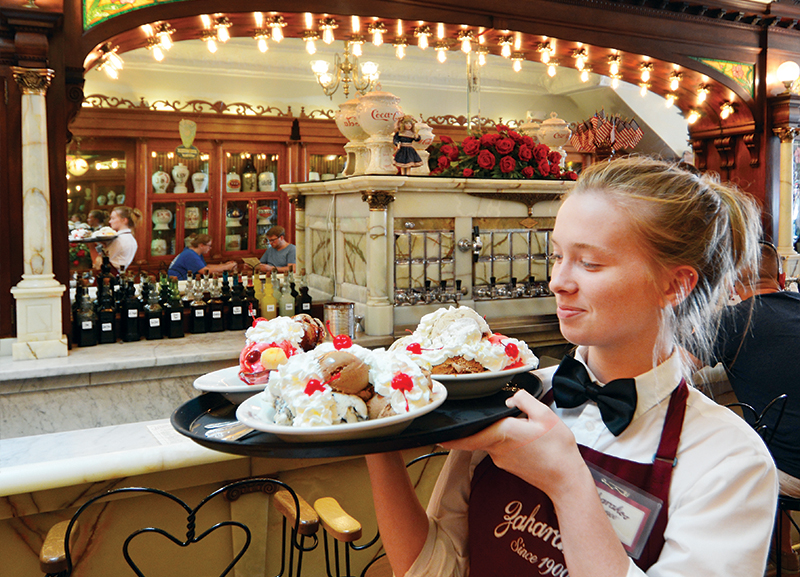 8
8
Zaharakos Ice Cream Parlor and Museum, Columbus.
After a day of visiting the outdoor architectural sites of Columbus, come into Zaharakos and let your senses feast. Your eyes will love its turn-of-the-century soda fountains, restored stained glass, marble pillars; your ears will feast on the sounds of mechanical musical machines that play at the drop of a coin; and, perhaps best of all, your taste buds and tummy will feast on honest-to-goodness goodies like old-times fountain sundaes, floats, milk shakes, malts and phosphates and ice cream sodas.
Originally, it was a candy store when the four Zaharako brothers, Greek immigrants, opened it in 1900. But by 1911, Zaharakos had transitioned into an parlor and fountain purveying some of the treats it still serves today.
In 2007, it was restored to its turn-of-last-century glory. An adjoining museum houses mechanical musical instruments and soda fountain relics. Visitors wanting something a bit more substantial before diving into the sweets, will find a generous menu of sandwiches, sides, salads, chili and macaroni and cheese. Zaharakos is famous for its version of Sloppy Joes, the Gom Sandwich, and its giant hand-cut, hand-breaded tenderloin.
9
Edinburgh Premium Outlets, Edinburgh.
Located at the intersection of U.S. 31 and I-65 between Taylorsville and Edinburgh, Edinburgh Premium Outlets has every shopping need covered with 85 stores. You’ll also find a variety of restaurants and antique stores surrounding the complex.
10
 Prisoner of War Chapel, Johnson County.
Prisoner of War Chapel, Johnson County.
After the U.S. entry into World War II, the newly-established Army training ground, Camp Atterbury, became the destination for about 15,000 Italian and German POWs. In 1943, some Italian POWs requested permission to build a tiny Roman Catholic chapel in a quiet corner of the camp. The POWs used leftover brick and stucco to create the 11-by-16-foot chapel. The paintings included portraits of Jesus, Mother Mary and the Holy Spirit, depicted as a dove.
After the war, the abandoned “Chapel in the Meadow” fell into disrepair. While Atterbury remains an active National Guard base, the land with the chapel was returned to the county. It later became part of Johnson County Park, and, in 1988, the chapel was restored.
 11
11
Grave(s) in the Middle of the Road, Amity.
When pioneering farm wife Nancy Kerlin Barnett died at the age of 38 in 1831 in Johnson County, she was buried as she requested: on a grassy hill near Sugar Creek.
In 1905, county officials decided to build a bridge over the creek and a road — right through her gravesite. Local lore maintains that when workers arrived to move Barnett’s remains, her grandson was standing vigil with a shotgun in hand. That led to a compromise: Her grave stayed, and what became County Road 400 South split in the middle with the lanes of the east-west road diverting to either side around it.
The “Grave in the Middle of the Road,” just east of U.S. 31, was a curiosity for over a hundred years but also a minor traffic hazard.
In 2016, the road was widened and the grave lowered to make the road safer for motorists. When Barnett’s remains were temporarily removed during the work, the remains of at least seven others — two women, a man and four children who were most likely relatives of Barnett — were also discovered. The group was reinterred in what should now be called the “Graves in the Middle of the Road.”
12
Johnson County REMC, Franklin.
Founded in 1935, the REMC serves over 21,000 members in Johnson and portions of Brown, Morgan and Shelby counties.
13
Soldiers’ and Sailors’ Monument, Indianapolis.
Technically, U.S. 31 today detours east around Indianapolis, sharing the road with the I-465 beltway. But before 465 was built a half century ago, U.S. 31 ran right into the heart of downtown Indianapolis. And that’s the route we’ll take for a number of don’t-miss sites in the capital city.
One of the most iconic symbols of Indianapolis is the Soldiers’ and Sailors’ Monument on the circle in the very center of the city. Begun in 1888 and dedicated in 1902, the 284-foot-6-inch monument honors Hoosier veterans of the wars to that point and was the first in the United States dedicated to the common soldier.
14
White River State Park, Indianapolis.
The park on Indy’s near west side covers 250 acres along the White River. And despite its name, it is not a “State Park” managed by the Indiana Department of Natural Resources.
Among the attractions located in or near the park are the Indiana State Museum, the Indianapolis Zoo, the Eiteljorg Museum of American Indians and Western Art, the NCAA Hall of Champions, Victory Field (home of Indianapolis Indians Triple-A minor league baseball team), and an outdoor concert venue.
15
Indiana World War Memorial Plaza, Indianapolis.
North of Monument Circle, the five-city-block plaza is home for national and state headquarters of the American Legion. The plaza includes the Indiana World War Memorial Building; Obelisk Square; more recent semi-circular memorials to World War II, the Korean War and Vietnam War; and more.
16
Children’s Museum, Indianapolis.
The museum on Meridian Street is the world’s largest dedicated to children. Its 472,900 square feet over five floors of exhibit halls receives more than 1 million visitors annually. The museum’s focus is family learning; most exhibits are designed to be interactive, allowing children and families to actively participate.
17
Indiana State Fairgrounds, Indianapolis.
Few locations and events in Indiana need less introduction than the fairgrounds and its biggest annual event, the State Fair. Some 900,000 visitors attend the fair each year. This year’s fair is Aug. 3-19.
18
Wilson Farm Market, Arcadia.
North of the congested Indy/Carmel corridor, U.S. 31 resumes on its own as a major modern highway with four (or more) lanes. As it re-enters the Hoosier countryside, up pops the Wilson Farm Market on the east side of the highway.
For over 40 years, friendly owners Bill and Judy Wilson have gathered up a wide variety of fresh and vine-ripened produce from their neighbors’ fertile fields and offered it directly to customers.
And, perfect for road trips, picnics or tailgating gatherings at that golden-domed university farther up the road in South Bend, the newly renovated store also offers fresh bakery goods, deli meats and cheeses; hand-dipped ice cream; old-fashioned candies; pies; jellies and jams, and much more!
19
The Kelley Agricultural Historical Museum, Sharpsville.
Just south of where the “new” U.S. 31 diverts to the east around Kokomo, is a collection of eclectic structures from the 1800s and early 1920 on 125 acres. Now also serving as a venue for celebrations and events of all kinds, the restored buildings include a round barn, farmhouse, red brick school house, log cabin, a blacksmith shop and more.
Tours are available upon request by calling 765-963-2963.
20
Elwood Haynes Museum/First “Road Trip” by Horseless Carriage, Kokomo.
The first road trip by car, notes a historical marker, passed over what became U.S. 31 in Kokomo July 4, 1894. That was the Haynes Horseless Carriage inaugural test drive over “a 6-mile course” on the old Pumpkinville Pike. Appropriately, the marker is on the same block on Kokomo’s east side as the giant manufacturing facilities, past and current, for General Motors, GM Components Holding and Chrysler Transmission.
Haynes was an inventor, scientist, industrialist, educator and philanthropist who is credited with being the first to produce cars commercially. His 1916 mansion, where he lived until his death in 1925, is now preserved as a public museum.
21
Grissom Air Museum (and Air Reserve Base), Bunker Hill.
One of the nation’s fastest growing aviation museums, Grissom has 25 military aircraft on display, a five-story Cold War Security Alert Tower, cockpits or trainers, and more. It sits on the fringes of the Grissom Air Reserve Base, home to the 434th Air Refueling Wing.
Formerly called Bunker Hill, the base was renamed in 1968 in honor of Virgil I. “Gus” Grissom, the Indiana astronaut who perished in the Apollo I fire in 1967.
22
Peru Amateur Circus, Peru.
Every year, approximately 200 young people, ages 7 to 21, present 10 circus performances during an eight day festival in mid-July. Other circus performers and a huge number of volunteers join together to support these talented performers.
Peru’s Circus City Festival, Inc., was formed in 1960 to reawaken the area’s rich circus heritage that dates back to the late 1800s. Along with the performances, the Circus City Center in downtown Peru also hosts a museum filled with photos, miniatures, displays, and costumes from circus past.
23
Miami-Cass REMC, Peru.
Headquartered atop the hill on U.S. 31 (just north of U.S. 24), the REMC serves 6,000 consumers in Miami, Cass, and parts of Wabash counties.
24
McClure’s Orchard/Winery, Peru.
Served electrically by Miami-Cass REMC, the family-run facility, located north of Peru on the west side of U.S. 31, is a flourishing orchard and farm open year-round. Along with apple treats and ciders, hard ciders and wines, McClure’s also offers a gift shop, petting zoo and a café (opened Tuesday through Sunday from 10 a.m. to 6 p.m.), and has facilities to accommodate a variety of events, from field trips to weddings.
25
 Vohne Liche Kennels, Denver.
Vohne Liche Kennels, Denver.
For being the world’s largest and most renown trainer of police, military and security service dogs, Vohne Liche Kennels keeps a low profile with the general public. Its 350-acre K-9 campus on the east side of U.S. 31 near the Miami/Fulton county line is served electrically by Miami-Cass REMC.
But since 1993, Vohne Liche has trained dogs for over 5,000 law enforcement and government agencies in 49 states and 40 nations. Officers come to northern Indiana from around the world to learn how to handle their new highly-trained K-9 partners.
In addition to three large kennels which maintain 120-160 dogs at any given time, Vohne Liche’s facilities include an obstacle course, outbuildings and off-site structures to train the dogs in real-world environments.
Vohne Liche hosts its annual “K-9 Olympics,” Aug. 20-24, during which officers from around the world and their K-9s will compete in a variety of different exercises to test their training and skill. Vohne Liche founder Kenneth Licklider said many of the exercises will be open to anyone in the general public interested in watching how these incredible working animals help keep us all safe on the streets, in airports and more.
Following the competitions, Vohne Liche hosts a music fest for the participants on Aug. 24-25. This year’s musical lineup includes the popular band Foreigner. Licklider said anyone can also come to the free show — “as long as they’re well behaved.” With the majority of attendees being highly-trained law-enforcement officers of both the K-9 and human variety, hopefully that shouldn’t take too much convincing.
26
Fulton County REMC, Rochester.
Founded in 1936, the REMC serves almost 6,000 members in Fulton and parts of Cass, Kosciusko, Marshall, Miami, Pulaski, and Starke counties.
27
Fulton County Historical Society Museum/Round Barn/Village, Rochester.
Located on U.S. 31 four miles north of Rochester, the historical society grounds include a museum, a full-sized round barn and a village of restored historical buildings depicting the 1900-1925 time period. The grounds play host to the Trail of Courage Living History Festival in September and the Redbud Trail Rendezvous in April.
28
Marshall County REMC, Plymouth.
Incorporated in 1935, the REMC serves 6,000 members, mostly in Marshall County but also in parts of Elkhart, Fulton, Kosciusko, St. Joseph and Starke counties.
29
Potato Creek State Park, North Liberty.
Located a few miles west of U.S. 31, the park offers a wide array of natural features for year-round enjoyment including the 327-acre Worster Lake, old fields, mature woodlands, restored prairies, and diverse wetlands. The park is also noted for its 6.6 miles of wooded mountain bike trails.
Other activities and facilities include hiking trails, a nature center, wildlife observation area, cultural arts programs, a swimming area, fishing, shelters, bridle trails, camping and cabins, canoeing and more.
30
Potowatami Zoo, South Bend.
As in Indianapolis and Kokomo, U.S. 31 now diverts around the city of South Bend. But just off its older route through town is the Potawatomi Zoo. The zoo began in 1902 and bills itself as the oldest zoo in Indiana. Located along the northeast side of the famed south bend in the St. Joseph River (that gives South Bend its name), the zoo covers 23 acres with over 500 animals. It specializes in large cats, primates and Australian animals.
 31
31
Studebaker National Museum, South Bend.
What better way to wrap up a road trip than a stop at a museum devoted to cars?
The Studebaker National Museum is a state-of-the-art, 55,000-square-foot facility that opened in 2005 to honor and perpetuate the legacy of the famed South Bend automaker and those in the community who produced them.
Studebaker began as a wagon manufacturer in South Bend in 1852. It entered the nascent automotive business in 1902 with electric vehicles and then gasoline vehicles, all sold under the name “Studebaker Automobile Company.” Over the next 50 years, the company established a reputation for quality and reliability.
But by the 1950s, financial problems began taking a toll. By the end of 1963, the South Bend plant ceased production. And the last Studebaker automobile rolled off its Hamilton, Ontario, Canada, assembly line, sadly coincidentally, March 17, 1966. No luck of the Irish there for the one-time South Bend automaker.



